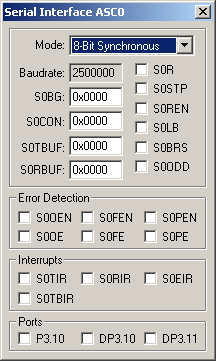|
||
| Products Download Events Support Videos | ||
Product Information
Device Database®
Downloads
Compliance Testing
Distributors
Peripheral Simulation
For Infineon XC2321D-12F — Asynchronous/Synchronous Serial Interface ASC0
Simulation support for this peripheral or feature is comprised of:
- Dialog boxes which display and allow you to change peripheral configuration.
- VTREGs (Virtual Target Registers) which support I/O with the peripheral.
These simulation capabilities are described below.
Serial Interface ASC0 Dialog

The Serial Interface ASC0 dialog displays and allows you to edit the configuration of the Asynchronous/Synchronous Serial Interface. The controls in this dialog are separated into several logical groups.
The Mode group contains the following controls.
- Mode displays and allows you to change the serial interface mode of operation (data length and synchronous or asynchronous).
- Baudrate is the actual baudrate.
- S0BG is the ASC0 Baudrate Generator Reload Register (SFR).
- S0CON is the ASC0 Control Register (SFR).
- S0TBUF is the ASC0 Transmit Buffer Register (SFR).
- S0RBUF is the ASC0 Receive Buffer Register (SFR).
- S0R enables the baudrate generator.
- S0STP specifies the number of stop bits (cleared for 1, checked for 2).
- S0REN enables serial data reception.
- S0LB enables loopback mode.
- S0BRS specifies how the baudrate is generated (cleared to divide clock by reload+constant, checked to reduce serial clock to 2/3).
- S0ODD specifies the parity to use (cleared for Even, checked for Odd).
The Error Detection group contains the following controls.
- S0OEN enables overrun checking.
- S0OE indicates an overrun error was detected.
- S0FEN enables frame checking.
- S0FE indicates a framing error was detected.
- S0PEN enables parity checking.
- S0PE indicates a parity error was detected.
The Interrupts group contains the following controls.
- S0TIR is the ASC0 transmit interrupt request flag.
- S0RIR is the ASC0 receive interrupt request flag.
- S0EIR is the ASC0 error interrupt request flag.
- S0TBIR is the ASC0 transmit buffer interrupt request flag.
The Ports group contains the following controls.
- P3.10 is the state of the TxD0 output pin.
- DP3.10 is the data direction register for the TxD0 pin.
- DP3.11 is the data direction register for the RxD0 pin.
S0IN VTREG
Data Type: unsigned int
The S0IN VTREG represents the ASC0 serial input of the simulated microcontroller. Values you assign to S0IN are input to the serial channel. You may assign input using the command window. For example,
S0IN='A'
causes the simulated microcontroller serial input to receive the ASCII character A. If you want to use the S0IN VRTEG to simulate reception of multiple characters, you must be sure to delay for at least one character time between successive assignments to S0IN. This may be done using a signal function. For example:
signal void send_cat (void) {
swatch(0.01); /* Wait 0.01 seconds */
S0IN='C'; /* Send a C */
swatch(0.01);
S0IN='A';
swatch(0.01);
S0IN='T';
}
You may use the S0IN VTREG to input more than 8 bits of data. For example,
S0IN=0x0123
inputs a 9-bit value. In addition to the S0IN VRTEG, the serial window allows you to input serial characters by simply typing. Serial characters that are transmitted byt the simulated microcontroller appear in the serial window.
S0OUT VTREG
Data Type: unsigned int
The S0OUT VTREG represents the serial output from the simulated microcontroller. Whenever the simulated serial port transmits a character, the value transmitted is automatically assigned to S0OUT (which is read-only). You may read the value of S0OUT to determine the character transmitted by your simulated program. For example,
S0OUT
outputs the value of the last character transmitted. You may use the S0OUT VTREG in a script to process transmitted data. For example,
signal void s0out_sig (void) {
while (1)
{
wwatch(S0OUT); /* wait for something in S0OUT */
printf ("Transmitted a %2.2X\n", (unsigned) S0OUT);
}
}
S0TIME VTREG
Data Type: unsigned int
The STIME VTREG allows you to control the timing of the simulated serial port.
- A value of 1 (which is the default) indicates that the serial port timing is identical to the target hardware. Use this value when you want to see the effects of baud rate on the serial port I/O.
- A value of 0 indicates that all serial input and output occur instantaneously. Use this value when you don't care about any baud rate effects or when you want serial output to be fast.
For example:
S0TIME = 0 /* Set Serial Port for FAST timing */ S0TIME = 1 /* Set Serial Port for accurate timing */
ProductsDevelopment Tools |
Hardware & Collateral |
Downloads |
Support |
Contact |
